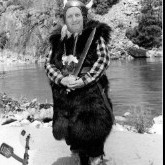-
Posts
1,378 -
Joined
-
Last visited
Profile Information
-
Gender
Male
-
Location:
Northern California
-
Interests:
Gold, Hiking, Geology, Desert
-
Gear In Use:
GPZ 7000+19/ NF12-Zsearch, SDC 2300, GPX 6000 (+17 in + Goldhawk 9, NF 12 x 7), Manticore, Gold Monster 1000
Recent Profile Visitors
5,125 profile views
Gold Catcher's Achievements

Gold Contributor (5/6)
2.8k
Reputation
-
I find this response disapointing. What would it cost them to put this in the box as an optional accessory? Leave it up to the user to deceide what lower shaft to use. And for the price tag of the Manticore that little expense would not matter at all. Kind of sad if you look at the legacy of this company and now you have to rely on a third party vendor to make their detectors right. They do advertise the gold mode of the Manticore and praise how good it is, after all. GC
-
Thanks Phrunt. Well, there we have it. I do understand their reasoning regarding the Manticore being a C&T machine, but yet a good number of gold prospectors use advanced VLF machines for hunting gold in trashy areas, and might just buy them for this specific purpose. And they are out of luck with a conductive lower rod. I also think they vastly understate the problems with the gold mode issues. It is way more screaming than any EMI interference, up to a point where it is almost not usable. Oh well. Steve's fiberglass rod will be the answer for me. GC
-
Can't wait Steve. Still wonder though how ML will respond to all this. Clearly a design flaw. They should offer non conductive lower rods for all customers for free, or say that it is just a relic hunting machine only....Still puzzled that the testers never noticed. Such an obvious issue in gold mode, and the extreme motion and bump senitivity should have alerted them to investigate. They would have eventually figured out what DP uncovered for them. GC
-
High Country to Beat the Heat!
Gold Catcher replied to LuckyLundy's topic in Detector Prospector Forum
Nice finds! I know that place too, went there several times to escape the heat. Will be back there in 2 weeks if you want to meet up.🤠 Scenery is gorgeous but gold is rather spotty. The place where you took the pic with your dog is good and surrounded by several placer diggings. Also, very different geology to the left and to the right of the street when driving down before going on the dirt road to the right..😉 GC -
PI Detectors But What’s Behind Door 4 ?
Gold Catcher replied to Ridge Runner's topic in Metal Detector Advice & Comparisons
I think the biggest market share will be in the low-cost PI space (<3k), and if they are smart, they will target the Algoforce customer profile with whatever tech is possible at this price point. The VLF market is only so rich in choices because the VLFs are also low cost, and it is easier to compete in the low-cost customer base. When it comes to the high-end market the choices will always be fewer, mostly because many won't be able to afford it and the R&D cost are much higher. And those who can afford this price class will expect a lot from their detectors, and here is where ML will always have a leading-edge IMO. When it comes to the 7000, I don't think anyone is capable of or has the means to develop a match/successor other than ML itself, and only very few will be able to afford it, hence impact on overall market share will be limited. And I also suspect that this is why we haven't seen one already. GC -
For me, digging everything with a PI is still the safest method, in particular when paired with "selective detecting". What I mean with that is that I do alot of scraping and digging, before I even start detecting. By a river I think about where gold could be (think like gold), then I start removing rocks and dig holes before I even start firing up my detector. On a typical 8h detecting day I find myself roughly 4 hour digging and 4 hour detecting. This method can be productive, since gold is usually not just laying around (anymore) for easy detecting. So, if I just wander around by a river and detect I seldomly find anything, unless I really dig. In the desert I most often do the boot scrape method but then detect everything that's left when using PI or ZVT. The VLF I most often use for tailing piles and then strictly go by ID, but caveats need to be understood. GC
-
Official Steve H Conductive Rod Test
Gold Catcher replied to Steve Herschbach's topic in Detector Prospector Forum
You guys in NZ just don't have the kind of dirty hands we yankees have 🤪 -
Conductive Carbon Fiber Lower Rods
Gold Catcher replied to Steve Herschbach's topic in Detector Prospector Forum
I think Steve H said it all. Why debating this issue? If there is reason for concern with the CF shaft being a problem (with ample proof now available), then just use a different non conducting rod. Problem solved. Same with metal containing boots. Just don't wear any if you have an alternative. Fact is that I bought a 1.6k machine for gold prospecting and I have a conductive rod that lights up in gold prospecting mode. That is a design screw up, plain and simple, unless you never would prospect for gold. I am already on Steve's lower shaft list. Whether it fixes all problems or not does'nt matter. I just don't want a conductive rod at all in principle. It would not make any sense. GC -
Conductive Carbon Fiber Lower Rods
Gold Catcher replied to Steve Herschbach's topic in Detector Prospector Forum
Thanks for doing all this Phrunt! ML should consider you as a tester. GC -
Whatever the reason, shaft issues, hypersensitive electronics, wrong wiring, I have no idea. But the Manticore sucks in bump senitivity in gold mode. Even when you don't touch anything just strong wind can cause the chatter. I am actually really suprised that the testers did not pic that up. Or, they just had relic hunters test it who never used the gold mode. However, no wind, no touching anything, no fly landing on the coil, and the Manti is brilliant for shallow gold in trashy sites. GC
-
This is a forum like no other, and there is nothing out there that I know of that comes even close. Steve, I agree with Northeast if there is anything that you need for professional help to be paid to fix the problem, please reach out to me. This forum is and has been an inspiration for me, like I am sure for many others. Let's keep the dream alive. And besides, I bet virtually every detector company is following this forum to get feedback on their products, be alerted of issues, and to understand where the next product lines should go. In fact, I bet they would pay for all of what you need, just to keep this forum alive for their own sake 🙂 GC
-
Using The 7000 To Pick Up The Scraps Missed By The 6000
Gold Catcher replied to Lesgold's topic in Detector Prospector Forum
Size and depth matters for me when comparing 6k and 7k. For shallow <=5 inch fast gold the 6k beats the 7k when run hot, no doubt. For depth > 5 inch the 7k beats the 6k in HY/Normal, even when the gold remains very small. So, it is not just the coil size that matters, it is the ground processing ability that the Z has that is just unmatched and that favors small gold recovery at depth. So, there is no "general cleanup detector" IMO. It all depends on the conditions and for what type of gold size/depth the cleanup needs to be done. The NF!2 is the ideal coil for the Z IMO to balance depth/sensitivity and DOD configuration to support optimal ground processing. I have found gold with the 7/NF12 that did not register on a 3 digit scale. Pretty impressive sensitivity even for tiny gold. But important are also the settings used. With smoothing on and in difficult the fast gold is often too fast.... GC -
Using The 7000 To Pick Up The Scraps Missed By The 6000
Gold Catcher replied to Lesgold's topic in Detector Prospector Forum
Beautiful finds. The Z with the NF12 remains my preferred detector for a reason. GC







